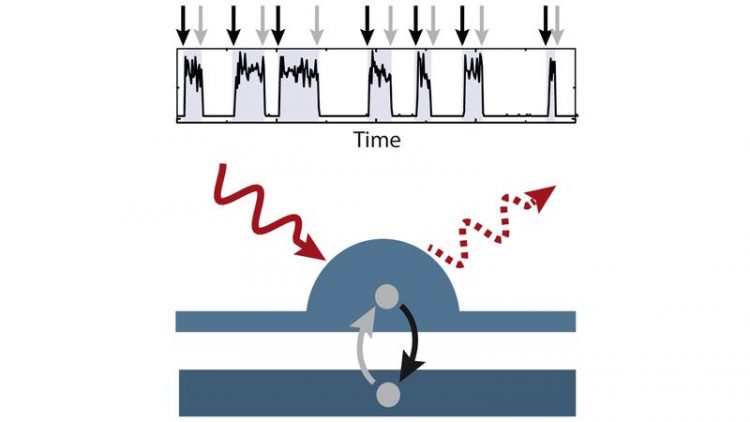Dynamics in quantum dots: Smallest measurable processes recorded individually

Illustration of the measuring method M. P. Geller, UDE
The experimental setup included a quantum dot – i.e. a solid structure of only about 10,000 atoms – next to a reservoir with electrons. About 100 times per second an electron jumps back and forth between this structure and the reservoir.
It can jump into a high or low energy state into the quantum dot and change inside from top to bottom. For the first time, the researchers were able to observe this change through these tiny jumps.
“This measurement of every single quantum jump is the maximum information that can be extracted from a quantum system, because there aren’t any other or faster processes that can be measured”, explains Dr. Martin Paul Geller from the Collaborative Research Center 1242 Non-Equilibrium Dynamics of Condensed Matter in the Time Domain.
For the project, the team of experimental physicists collaborated with colleagues from theoretical physics in the working group of Professor Dr. Jürgen König (UDE). The theoretical physicists statistically analyzed the data and for the first time could made statements about the dynamics of the electrons in the quantum dot.
“In principle, we worked with a highly-sensitive optical and fast microscope that has still much room for improvement”, says Geller describing the measurement technology that has been refined by the researchers. Further optimization could outperform any electrical measurement in speed and spatial resolution.
Dr. Martin Paul Geller, Faculty of Physics, +49 203 37 9-2237, martin.geller@uni-due.de
Optical Detection of Single-Electron Tunneling into a Semiconductor Quantum Dot
A. Kurzmann, P. Stegmann, J. Kerski, R. Schott, A. Ludwig, A. D. Wieck, J. König, A. Lorke, and M. Geller
Phys. Rev. Lett. 122, 247403 (2019)
https://doi.org/10.1103/PhysRevLett.122.247403
Media Contact
More Information:
http://www.uni-duisburg-essen.de/All latest news from the category: Physics and Astronomy
This area deals with the fundamental laws and building blocks of nature and how they interact, the properties and the behavior of matter, and research into space and time and their structures.
innovations-report provides in-depth reports and articles on subjects such as astrophysics, laser technologies, nuclear, quantum, particle and solid-state physics, nanotechnologies, planetary research and findings (Mars, Venus) and developments related to the Hubble Telescope.
Newest articles

Superradiant atoms could push the boundaries of how precisely time can be measured
Superradiant atoms can help us measure time more precisely than ever. In a new study, researchers from the University of Copenhagen present a new method for measuring the time interval,…

Ion thermoelectric conversion devices for near room temperature
The electrode sheet of the thermoelectric device consists of ionic hydrogel, which is sandwiched between the electrodes to form, and the Prussian blue on the electrode undergoes a redox reaction…

Zap Energy achieves 37-million-degree temperatures in a compact device
New publication reports record electron temperatures for a small-scale, sheared-flow-stabilized Z-pinch fusion device. In the nine decades since humans first produced fusion reactions, only a few fusion technologies have demonstrated…





















